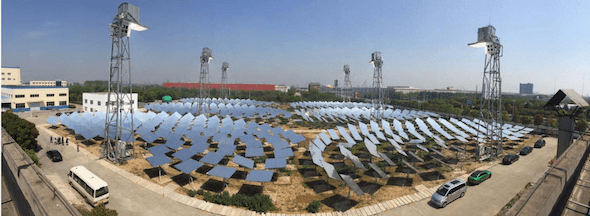New South Wales-based solar thermal technology developer Solastor Australia is set to launch a proposal for the development of a solar thermal and storage plant of up to 170MW in Port Augusta, South Australia, that it says will provide the state with 24/7 base load and peak load generation.
The “game-changing” billion-dollar project, based on Solastor’s Australian-made and owned solar thermal tower technology, is being launched on Tuesday in Adelaide by the company’s chairman, prominent economist and former leader of the Liberal Party, Dr John Hewson.
It will compete with another proposed solar tower and storage project, a 110MW facility put forward by US company SolarReserve. Numerous other projects, including solar PV or wind, or both, including a 200MW facility put forward by the former boss of the Hazelwood brown coal power generator, are also being mooted.
Both Labor and the Coalition have suggested that they will support funding rounds for large-scale solar thermal and storage projects should they win the upcoming election.
According to the Solastor launch invitation, the proposed plant has a total project budget of approximately $1.2 billion and will comprise 1,700 modules, with a generation capacity of 110MW in winter and 170MW in summer.
Once completed it will generate approximately 1.25 billion kWh of electricity per annum – enough to power more than 200,000 Australian homes.
A Sydney-based company, Solastor has been on RenewEconomy’s radar for some years now, after it won a share of $12.7 million in clean energy funding form the Western Australian government in 2012, to use its Australian-invented and owned technology to develop solar thermal plants in WA.
But the technology has been around for much longer. The thermal storage technology used in the Solastor system is owned by Larkden Pty Ltd, a company started by Robert Lloyd.
In 1999, Larkden was granted the initial patents around energy storage in graphite. Larkden then issued a head licence to Lloyd Energy Systems, a company which further developed the technology between 2001 to 2009.
In 2006, Solastor won government funding to build a 3MW facility at Lake Cargellico. The facility consists of 8 modules and a steam turbine and started producing electricity in May 2011.
Over the past few years, the team from Solastor has also been upgrading the technology and working on solar thermal projects in Cyprus (25MW and 50MW), Oman (7.5 MW) and Chile (5 MW).
Like other solar thermal systems, Solastor’s is capable of providing energy on demand, and around the clock, by storing the heat from the sun.
In Solastor’s case, this is done using computerised sun-tracking heliostats, which reflect the sun’s rays onto solar thermal receivers (STRs), which are mounted on relatively short 24-metre high towers.
The receivers contain 10 tonnes of high purity graphite, which can be heated to a maximum of 800°C, and store energy through non-daylight hours.

Once the sun goes down, or it gets cloudy, the entry point to the tower’s receiver is closed and sealed. And once the energy is stored, the high purity graphite ensures the thermal losses are very low.
During daylight hours, the accuracy of the heliostats is continuously monitored by a camera at the base of the tower and, if required, recalibrated by the plant’s computerised control system.
To produce electricity, purified water is pumped from a holding tank to the STRs, within the STRs the water passes through a series of pipes embedded in the graphite called heat exchangers, the hot graphite converts the water into super heated steam.
The steam is then directed to a turbine and electricity produced. After the steam leaves the turbine it is cooled and condensed and the water returned to the holding tank to be recycled – a feature the company says that, along with its use of air-cooled condensers, makes the Solastor System ideally suited to arid regions, with limited water supplies.
The Solarstor system is also modular, so can be scaled up or down to meet requirements, and can apparently be installed in sloping and hilly terrain, avoiding the need for the vast flat areas required by solar thermal troughs and high towers.
But the system’s most important feature is probably its “schedulability”. By sunset each day, the exact amount of energy stored is known, allowing a utility to decide how it wants that energy delivered over the subsequent 24 hours, with availability guaranteed.
The technology allows “heat in/heat out” simultaneously, so there are a number of possible scenarios on the following day, including recharging storage tanks at the same time as they are being emptied.
If the utility considers a “no sun” forecast for the following day, it has the option of taking out only half the stored energy (for example during peak hours) then keeping half in reserve for the next day (for peak hours).
We expect to learn more details about the project, and how it might be funded, in the days following the formal launch on Tuesday.










